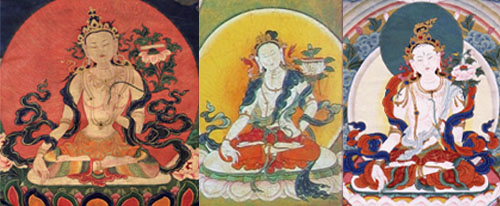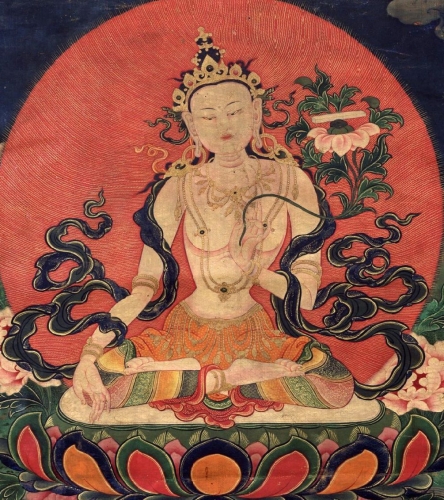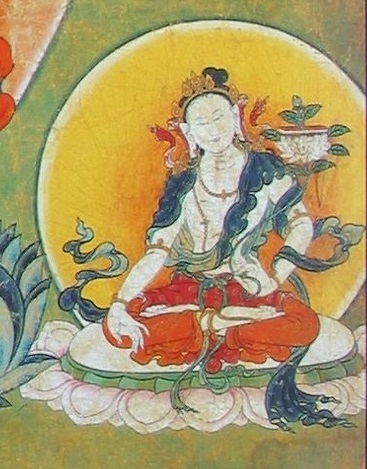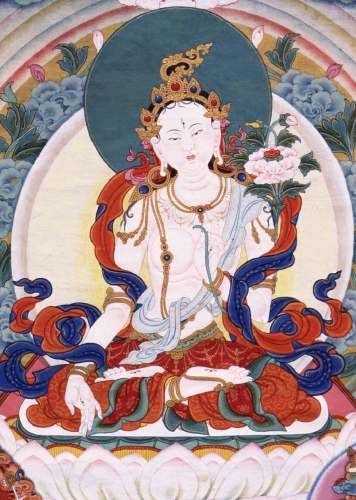Buddhist practice and Buddhist art have been inseparable in the Himalayas ever since Buddhism arrived to the region in the eighth century. But for the casual observer it can be difficult to make sense of the complex iconography. Not to worry—Himalayan art scholar Jeff Watt is here to help. In this “Himalayan Buddhist Art 101” series, Jeff is making sense of this rich artistic tradition by presenting weekly images from the Himalayan Art Resources archives and explaining their roles in the Buddhist tradition.
This week Jeff teaches us how to differentiate between deities exhibiting peaceful appearances.
Himalayan Art 101: Differentiating Among Peaceful Appearances

Why do these three images look the same and where should we look to find the differences among them?
These very similar images are often confused and mistaken for one another. They look the same because they are, essentially, the same. That is, they all fall under the category of Peaceful Appearance from the system of the Eleven Categories of Figurative Appearance in Himalayan and Tibetan art. This category is alternately known as Bodhisattva Appearance, God/Goddess Appearance, or Deva/Devi Appearance.
Peaceful deities appear as sixteen-year-old youths, male and female, and are described to inhabit the heavens of the Hindu, Jain, and Buddhist religious traditions. It is very difficult to differentiate between the male and female forms, which is on purpose.
 There are only two characteristics, or artistic conventions, employed by artists that help in distinguishing male from female. The first is the obvious, but not always so obvious, breasts; female deities, depending on the artist and the tradition, can have pronounced breasts. The second characteristic is the hairline on the forehead. Females have oval-shaped faces with the hairline following the pronounced upward curve of the forehead. Males, in contrast, have a flat, horizontal hairline, often with a widow’s peak—an artistic convention common only after the 15th century or so.
There are only two characteristics, or artistic conventions, employed by artists that help in distinguishing male from female. The first is the obvious, but not always so obvious, breasts; female deities, depending on the artist and the tradition, can have pronounced breasts. The second characteristic is the hairline on the forehead. Females have oval-shaped faces with the hairline following the pronounced upward curve of the forehead. Males, in contrast, have a flat, horizontal hairline, often with a widow’s peak—an artistic convention common only after the 15th century or so.
The three images presented here as examples are all white in color and peaceful in appearance, each with one face and two hands, seated in the same vajra posture. So, are the figures male or female? Are they all the same deity, or different forms of the same deity? Aside from the breasts and hairline, the only other varying characteristics are the hand gestures and the symbolic objects held in the hands.
The first image is of White Manjushri. His general appearance, white color, and symbolic attribute above the left shoulder are typical for this form of Siddha Kavira White Manjushri—a male deity. His body type and thin waist, however, cause him to appear feminine.
His general appearance, white color, and symbolic attribute above the left shoulder are typical for this form of Siddha Kavira White Manjushri—a male deity. His body type and thin waist, however, cause him to appear feminine.
The second image is surely the same deity simply repeated, isn’t it? Take a closer look. The forehead is the important characteristic to look at here. This second figure is White Sarasvati—a female. Aside from her gender, she is identical to White Manjushri. As we already know, there is little difference between male and female peaceful deities. Fortunately for us, the artist has drawn the face with an oval-shape and a high forehead, indicating her gender.
 The third example shares the basic characteristics of body appearance and color with the first two examples. Unlike the first two figures, however, this example does not contain a symbolic book attribute over the left shoulder. There is also the peculiar appearance of a vertical eye on the forehead, along with similar eyes on the palms of the hands and soles of the feet. This is the most significant distinction in this example. As for gender, the oval forehead should give it away immediately.
The third example shares the basic characteristics of body appearance and color with the first two examples. Unlike the first two figures, however, this example does not contain a symbolic book attribute over the left shoulder. There is also the peculiar appearance of a vertical eye on the forehead, along with similar eyes on the palms of the hands and soles of the feet. This is the most significant distinction in this example. As for gender, the oval forehead should give it away immediately.
Deities that fall into the category of Peaceful Appearance tend to appear very similar. The important differences among them rests first with gender, and then with body color and symbolic hand attributes.
Learn more about the category of Peaceful Appearance here.
For a closer look at the images, visit Himalayan Art Resources here and here.